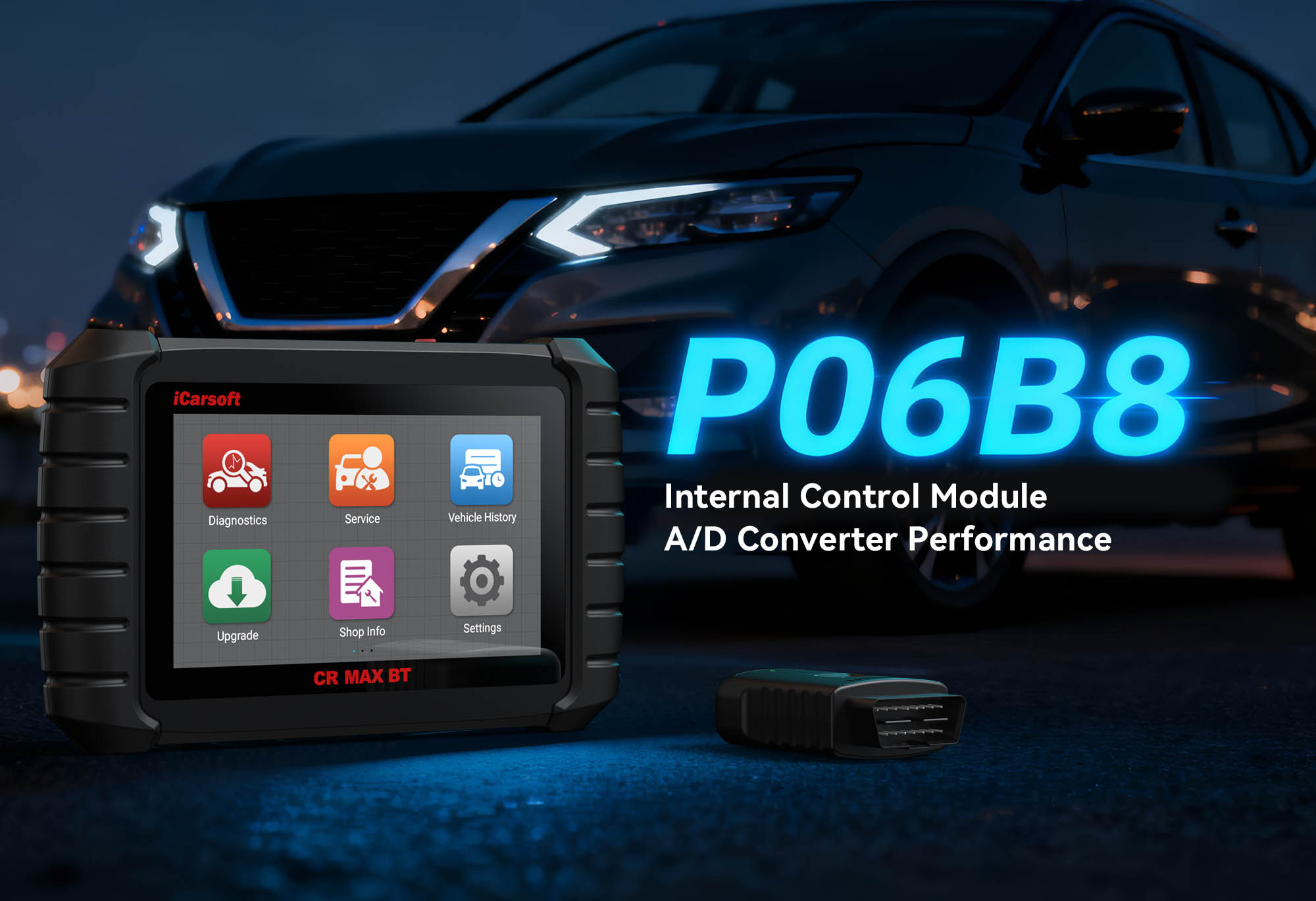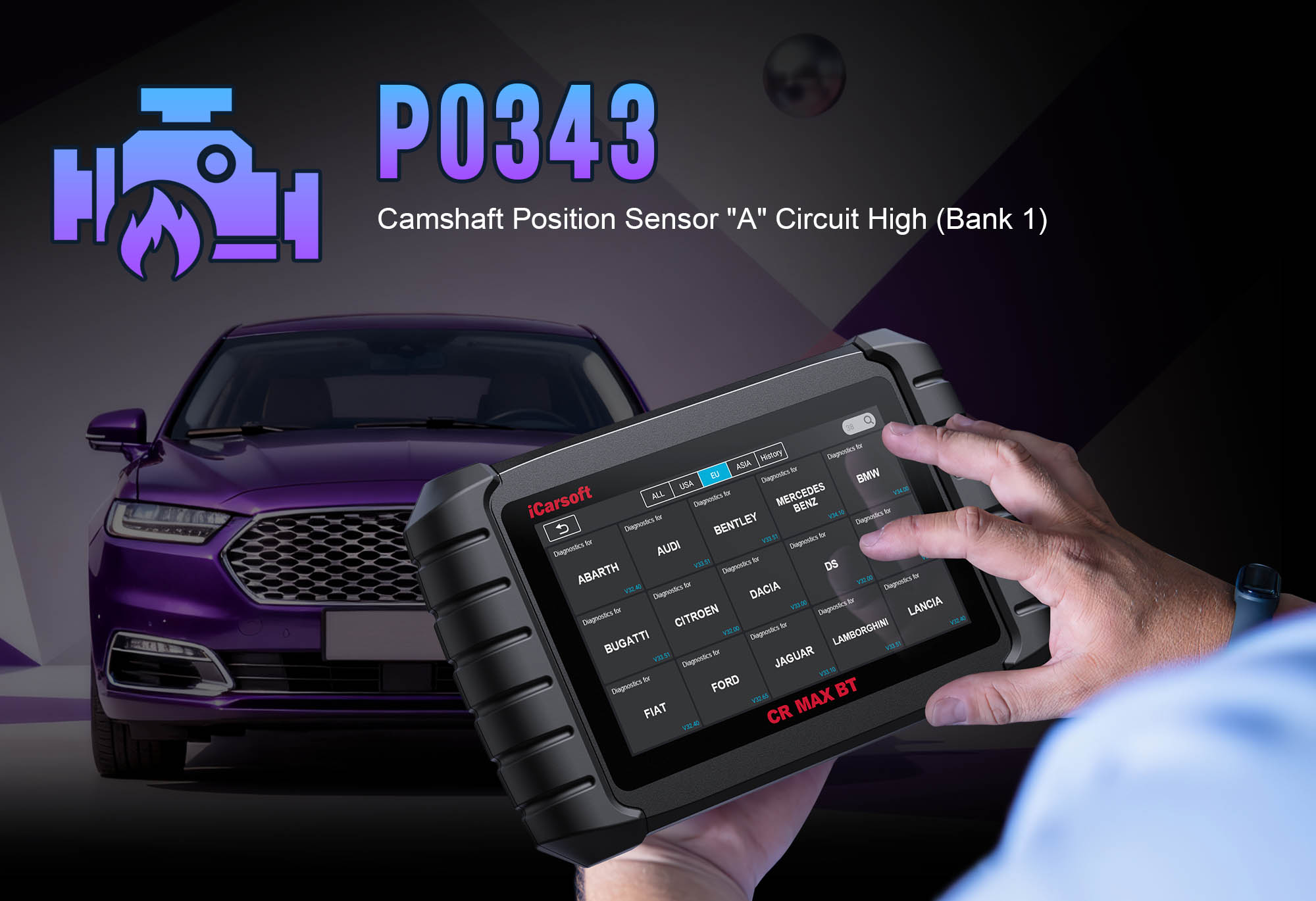Diagnose & Clear P2173 with iCarsoft CR Ultra P
If your vehicle idles erratically, stalls at stoplights, or triggers a check engine light after a battery replacement or throttle body service, a diagnostic scan will likely return P2173. This OBD-II code stands for "Throttle Actuator Control System - Idle Position Not Learned"—a critical fault indicating the Engine Control Module (ECM) has failed to memorize the throttle body’s correct idle position. The electronic throttle body relies on a learned idle position to maintain stable RPMs when the vehicle is stationary; without this data, the ECM can’t adjust airflow properly, leading to rough idling or stalling.
Basic scanners might only flag an "idle learning error" but can’t initiate the relearn process, monitor idle position accuracy, or reset the ECM’s memory—leaving you stuck with persistent idle issues. The iCarsoft CR Ultra P, with its OE-level throttle adaptation tools, real-time idle monitoring, and ECM reset functions, solves this. Let’s break down how to diagnose and resolve P2173 with precision, using the CR Ultra P’s unique features to teach the ECM the correct idle position and restore smooth idling.
Understanding P2173: Causes & Key Symptoms
The electronic throttle body’s idle position is a specific throttle plate angle (typically 5–10% open) that allows just enough air into the engine to maintain stable idle RPMs (600–800 RPM). The ECM "learns" this position during a calibration process, storing it in memory. P2173 triggers when the ECM loses the learned idle data (e.g., after a battery disconnect or ECM reset), the throttle body is replaced/cleaned (altering physical position), or sensor signals are erratic (preventing validation of the idle position).
Key Symptoms of P2173
-
Erratic Idle: RPMs fluctuate between 400–1,000 RPM at stoplights, causing the engine to shake.
-
Stalling at Idle: The engine dies when the vehicle is stationary, especially after cold starts.
-
High Idle: RPMs remain above 1,000 RPM at idle, even when the engine is warm.
-
Check Engine Light: Illuminates with no other obvious performance issues (acceleration may still feel normal).
-
Failed Emissions Tests: Unstable idle increases hydrocarbon emissions, causing test failures.
Common Causes of P2173
|
Cause
|
Description
|
|
Battery Disconnect or Voltage Drop
|
A dead battery or disconnect erases the ECM’s stored idle position data.
|
|
Throttle Body Service or Replacement
|
Cleaning or replacing the throttle body changes the plate’s physical position, requiring a new relearn.
|
|
Dirty Throttle Body
|
Carbon buildup on the plate alters airflow, making the old learned position invalid.
|
|
Faulty Throttle Position Sensors (TPS)
|
Erratic TPS signals prevent the ECM from accurately detecting the idle position.
|
|
ECM Software Glitch
|
Outdated firmware or corrupted memory prevents the ECM from completing the relearn process.
|
Why iCarsoft CR Ultra P Excels at Diagnosing P2173
P2173 is often a calibration issue, not a mechanical failure—and the CR Ultra P’s specialized features target this:
OE-Level Idle Relearn Function
Initiates the exact calibration sequence required by 200+ vehicle brands, ensuring the ECM memorizes the new idle position.
Real-Time Idle Monitoring
Tracks RPMs, throttle plate position, and TPS signals during relearn, verifying successful idle position learning.
Throttle Body Cleaning Validation
After cleaning, confirms the plate moves freely— a prerequisite for successful idle learning.
ECM Memory Reset
Clears corrupted idle data, allowing a fresh relearn process (critical after battery issues).
Global Vehicle Coverage
Supports makes like Ford, Toyota, BMW, and Audi, including 2018+ models with advanced throttle systems.
41 Hot Service Functions
Includes throttle adaptation, sensor validation, and emissions readiness checks—essential for post-repair verification.
Battery Tester Module
Verifies stable voltage (12.4–12.7V) required for relearn, preventing failed calibration due to power issues.
Step-by-Step: Diagnose P2173 with iCarsoft CR Ultra P
-
Safety First & Initial Checks
1. Ensure a Stable Power Supply: Use the CR Ultra P’s Battery Tester to confirm 12.4–12.7V; charge the battery if low.
2. Let the Engine Warm Up: Idle relearn works best on a warm engine (coolant temperature >176°F/80°C)—idle for 10–15 minutes.
3. Locate the Throttle Body: Use Component Location > Engine > Throttle Actuator to find the unit (mounted on the intake manifold).
-
Connect the CR Ultra P & Confirm P2173
Plug the CR Ultra P into the OBD-II port, power it on, and pair with the CR Link VCI (auto-connected via Bluetooth). Select AutoVIN Identify to retrieve engine type, throttle body specs, and ECM protocol. Navigate to Engine > Fault Codes > Read Codes to confirm P2173. Tap Code Details for insights (e.g., "Honda Civic: Throttle Actuator Control System - Idle Position Not Learned; Relearn Required After Battery Disconnect"). Note related codes (e.g., P2100, P2111) and resolve P2173 first.
-
Prepare for Idle Relearn
1. Check for Mechanical Issues: Remove the air intake hose, inspect the throttle plate for carbon buildup (clean if dirty), and verify free plate movement (no sticking).
2. Clear Existing Faults: Go to Engine > Fault Codes > Clear Codes to delete P2173 and related errors.
3. Monitor Live Data Readiness: Go to Engine > Live Data > Throttle Control and confirm: Coolant Temperature >176°F/80°C, Battery Voltage 12.4–12.7V, A/C and Headlights turned off (no electrical load).
-
Perform Idle Position Relearn with CR Ultra P
1. Navigate to Engine > Special Functions > Throttle Adaptation > Idle Position Relearn.
2. Select your vehicle make/model (e.g., "Toyota > Camry > 2.5L 2018+").
3. Follow the tool’s brand-specific prompts (typically includes): Turning ignition to "ON" (engine off) for 10 seconds, starting the engine and idling for 5 minutes, avoiding pedal input.
4. The tool displays "Relearn Successful" when complete; if failed, it highlights issues (e.g., "TPS Signal Mismatch—Check Sensors").
-
Validate the Repair & Test Drive
- Confirm Idle Stability: Check Live Data > Engine RPM—should stabilize at 600–800 RPM. Monitor Throttle Plate Position (5–10% at idle, no sudden jumps).
- Test Drive: Drive 10–15 miles (stop-and-go traffic) and test with electrical loads (A/C, headlights) to verify stable idle.
- Post-Repair Code Check: Reconnect the tool and run Engine > Fault Codes > Read Codes—no P2173 or related codes confirms success.
Preventing P2173 Recurrence
-
Post-Service Relearn: Always run the idle relearn with the CR Ultra P after cleaning or replacing the throttle body.
-
Battery Maintenance: Use the tool’s Battery Test quarterly to avoid voltage drops that erase ECM memory.
-
Throttle Body Cleaning Schedule: Set a reminder in the CR Ultra P to clean the throttle body every 30,000 miles—prevents buildup-related position shifts.
-
Software Updates: Keep the CR Ultra P updated via One-Key Upgrade to access the latest relearn protocols for new vehicle models.
Conclusion
P2173’s "idle position not learned" fault is a calibration issue, not a mechanical failure—yet it can make daily driving frustrating. The iCarsoft CR Ultra P simplifies resolution with OE-level relearn tools, real-time monitoring, and ECM reset functions, ensuring the ECM memorizes the correct idle position quickly.
With 200+ brand coverage and 41 service functions, the CR Ultra P is more than a P2173 fix—it’s a long-term investment in smooth idling and reliable engine performance. Restore stable idle, avoid stalling, and drive with confidence—all with one professional-grade diagnostic tool.





